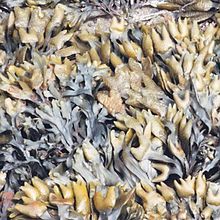Heterokonts
| Heterokonts | |
|---|---|
 |
|
| Pacific rockweed, Fucus distichus, in Olympic National Park | |
| Scientific classification | |
| Domain: | Eukaryota |
| (unranked): | SAR |
| Superphylum: | Heterokonta |
| Typical classes | |
|
Colored groups (alga-like)
Colorless groups
|
|
| Synonyms | |
|
|
Colored groups (alga-like)
Ochrophyta
Colorless groups
Pseudofungi
The heterokonts or stramenopiles (formally, Heterokonta or Stramenopiles) are a major line of eukaryotes currently containing more than 25,000 known species. Most are algae, ranging from the giant multicellular kelp to the unicellular diatoms, which are a primary component of plankton. Other notable members of the Stramenopiles include the (generally) parasitic oomycetes, including Phytophthora of Irish potato famine infamy and Pythium which causes seed rot and damping off.
The name "heterokont" refers to the type of motile lifecycle stage, in which the flagellated cells possess two differently shaped flagella (see zoospore).
Many heterokonts are algae with chloroplasts surrounded by four membranes, which are counted from the outermost to the innermost membrane. The first membrane is continuous with the host's chloroplast endoplasmic reticulum, or cER. The second membrane presents a barrier between the lumen of the cER and the primary endosymbiont or chloroplast, which represents the next two membranes, within which the thylakoid membranes are found. This arrangement of membranes suggests that heterokont chloroplasts were obtained from the reduction of a symbiotic red algal eukaryote, which had arisen by evolutionary divergence from the monophyletic primary endosymbiotic ancestor that is thought to have given rise to all eukaryotic photoautotrophs. The chloroplasts characteristically contain chlorophyll a and chlorophyll c, and usually the accessory pigment fucoxanthin, giving them a golden-brown or brownish-green color.
...
Wikipedia
